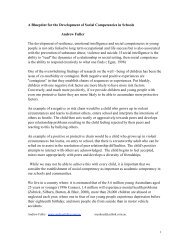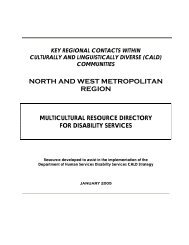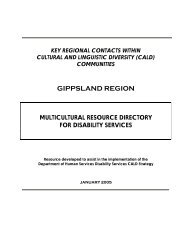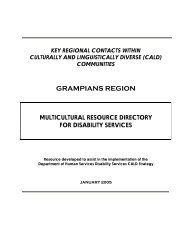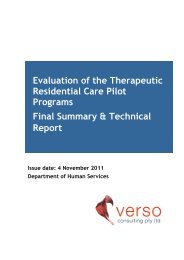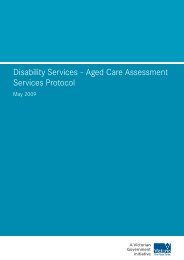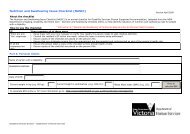Positive Behaviour Support - Department of Human Services - Vic ...
Positive Behaviour Support - Department of Human Services - Vic ...
Positive Behaviour Support - Department of Human Services - Vic ...
Create successful ePaper yourself
Turn your PDF publications into a flip-book with our unique Google optimized e-Paper software.
90 <strong>Positive</strong> behaviour support: Getting it right from the start - Facilitators reference manual<br />
PowerPoint 121*<br />
Summary<br />
Importance <strong>of</strong> monitoring, evaluating and reviewing the effectiveness<br />
<strong>of</strong> the positive behaviour support strategies<br />
As stated earlier positive behaviour support is not the simple answer to a complex question.<br />
A functional behaviour assessment can significantly assist in uncovering the purpose that the<br />
behaviour is serving for the person which can guide the selection <strong>of</strong> appropriate strategies;<br />
changes to the environment, teaching new skills, immediate response strategies. These<br />
strategies will require consistent implementation and a concerted effort from all those involved.<br />
There is little point in persisting with strategies if after a reasonable period <strong>of</strong> time there does not<br />
appear to be any change in the behaviour nor an improvement in the person’s quality <strong>of</strong> life. This<br />
is in turn can have a negative effect the person with a disability and on the enthusiasm <strong>of</strong> staff<br />
and their feelings <strong>of</strong> hope for the future.<br />
The importance <strong>of</strong> regularly monitoring the implemented strategies can not be understated.<br />
Consideration needs to be given to what strategies have worked and what strategies may<br />
need to change. This will <strong>of</strong>ten require interval data recording using STAR charts to identify any<br />
changes to the frequency <strong>of</strong> the behaviour and whether ideas formulated following the functional<br />
behaviour assessment about why the behaviour is occurring are still correct.<br />
In reviewing the selected strategies according to the Office <strong>of</strong> the Senior Practitioner, <strong>Behaviour</strong><br />
<strong>Support</strong> Plan Practice Guide it is important to consider;<br />
- the results <strong>of</strong> the positive interventions; that is what worked well in reducing the behaviours <strong>of</strong><br />
concern and what doesn’t work well to reduce the behaviours <strong>of</strong> concern and,<br />
- the results <strong>of</strong> the restrictive interventions; that is what was the effect <strong>of</strong> the restrictive<br />
intervention on the behaviour <strong>of</strong> concern and what was the effect <strong>of</strong> the restrictive intervention<br />
on the person’s quality <strong>of</strong> life.<br />
For people who are subject to restrictive interventions the need for monitoring and evaluation<br />
is crucial given the dangers associated with subjecting the person to restrictive interventions.<br />
These dangers include:<br />
• repeated traumatic experiences<br />
• the re-emergence <strong>of</strong> older behaviours<br />
• emergence <strong>of</strong> new behaviours<br />
• irreversible side effects associated with psychotropic medication (e.g. tardive dyskinesia)<br />
• physical injury to the person and even death in others.



